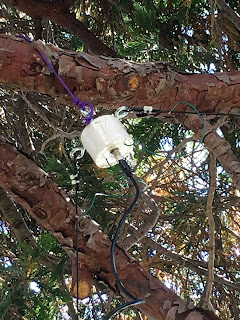I moved the circuit to copper, but no love. Still when I turn the bias up, it all goes haywire. Actually worse than before. Thinking it might have to do with the drive level, I tried adding an amplifier stage ahead of the 2n3053, but again no love.
Then I thought "hey, I sure have a lot of wires running around here..." I had been using hook-up wire to join my modules, as I didn't have any extra coax. But I did get some recently, so I added some BNC connectors to the output of the PA and the input/output of the LPF. Bam! Pretty output!
I'm getting 20v P-P on about 11.3V power, which is about 1 watt. I can get it up to about 1.5 watts by increasing the voltage to around 13V. But I'm hoping for 5W. Here at least some of the issue I think is the drive level. I tried the little amp I had, but I think that was overdriving it. Was getting about 3W out, but it was well ugly. Will need to have a think about what the drive level ought to be.
I might at some point see about using a different IRF510. I've read that "lower quality" parts may not work as well, and I'm not entirely sure about this one.
Edit: actually, after playing around in LTSpice, I think I may need to change out some of the coupling caps. The ones he uses in the Mighty Mike look to be attenuating things too much. In the simulation, if I change those to larger caps (closer to .1uf) and run it at the same power he does, I get >5W out, even with my current drive level. With his values and my current voltage, I get closer to what I'm getting on the bench.
Edit 2 (next day): I tried swapping out the .001uf for .1uf coupling caps as I mentioned in the last post. Raised the power some, but not nearly as much as in the simulation. I also tried swapping out the IRF510 for a new one from Mouser, didn't see much change.



